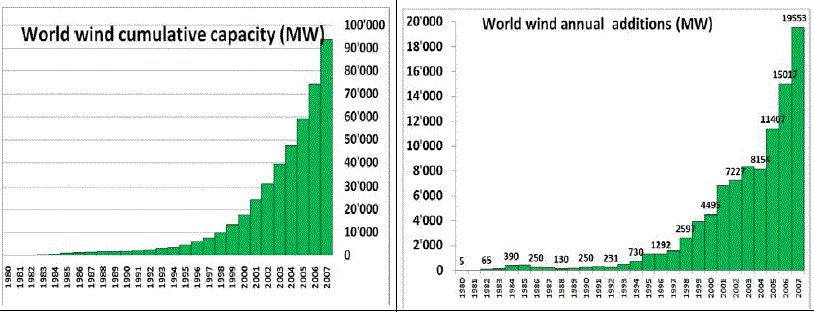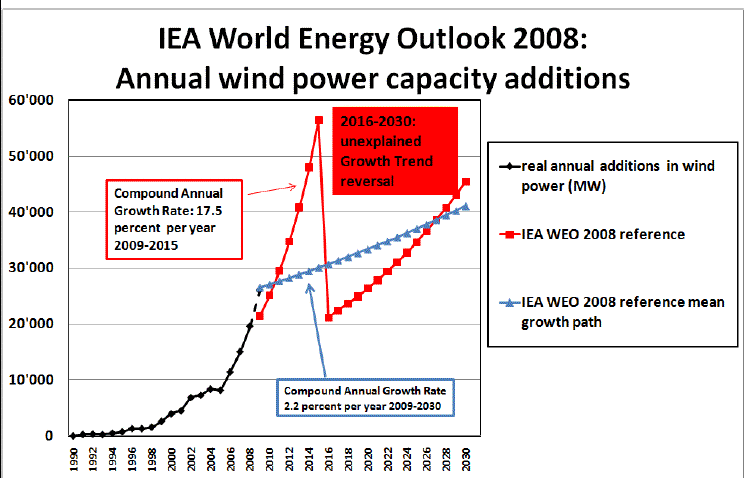
Figure 1 world wind power capacity and annual additions

Figure 4 IEA projection of annual wind capacity additions 20102030, from World Energy Outlook 2008
〔Energy Watch Group(2008)によるWind Power in Context - A clean Revolution in the Energy Sectorから〕
Abstract _______________________________________________________________________
7
1. Executive Summary _____________________________________________________
8
Misleading predictions and the role of IEA (International Energy
Agency) _________________ 10
The 2008 World Energy Outlook ___________________________________________________
11
The real significance of wind power: four scenarios ___________________________________
12
Model assumptions _____________________________________________________________
13
Model findings _______________________________________________________________________
17
Underlying Innovations __________________________________________________________
17
Social Innovation______________________________________________________________________
17
Far‐off Gigawatt clusters for wind _________________________________________________
18
Breakthrough in regulations ______________________________________________________
19
The problems of non‐renewables ________________________________________________________
20
Political opponents ____________________________________________________________________
21
Intermittency and interconnection ________________________________________________
21
Older natural gas plants as back‐up _______________________________________________________
21
2. Oil peak and the power sector
____________________________________________ 23
3. Wind power: Global market status
________________________________________ 26
Why is the situation in the wind market so different today from
what it was before? _______ 28
Struggling for take‐off (1996‐2005) ________________________________________________
29
“Teething problems” __________________________________________________________________
38
The Globalization of wind power: 2005 and beyond ___________________________________
40
Emergence of new markets _____________________________________________________________
42
The situation today _____________________________________________________________
45
World annual installations Growth Rates ___________________________________________
46
Component shortages _________________________________________________________________
47
The advantages of wind power ____________________________________________________
51
4. Four World Scenarios for the Wind Sector
___________________________________ 52
Preliminary remark _____________________________________________________________
52
Continuous growth of the wind sector projected _____________________________________
53
Model assumptions _____________________________________________________________
53
World electricity generation and consumption _______________________________________
55
The “effective power capacity” Concept ____________________________________________
56
Managing power reserves and interconnection _____________________________________________
57
Lower capacity factors . higher capital costs . lower fuel costs
_________________________________ 57
The “other renewables” sector ____________________________________________________
59
Development of the wind sector and market shares (accompanied
by solar) ______________ 60
Wind annual capacity additions ___________________________________________________
61
Overall market conquest by renewables ____________________________________________
62
Market development of non‐renewables and CO2‐emissions ___________________________
65
Non‐renewable power generation and CO2‐emissions _________________________________
66
The model’s meaning in real terms ________________________________________________
68
Territories for wind power ______________________________________________________________
68
Roofs and territories for solar ___________________________________________________________
68
Real market trends of wind power in 2007 __________________________________________
69
Comparisons with the real world __________________________________________________
70
China _______________________________________________________________________________
72
5. On the accuracy of Wind Power Installation
Forecasts ________________________ 73
Methodological remark __________________________________________________________
73
What do past forecasts on Germany tell us? _________________________________________
73
Cumulative capacity forecasts and reality: Germany __________________________________________
73
Annual additions forecasts and reality: Germany ____________________________________________
75
Outlook beyond 2007: Germany _________________________________________________________
76
What do past forecasts in Europe tell us? ___________________________________________
78
What do past forecasts for the world wind market tell us? _____________________________
84
Forecasts by the International Energy Agency _______________________________________________
84
The 2008 IEA “blue scenario” for the G8 ___________________________________________________
87
The IEA World Energy Outlook 2008 _______________________________________________
89
Revised oil supply and oil price projections _________________________________________________
89
World Energy Outlook 2008 and Wind power _______________________________________________
89
BTM Consult’s world market forecasts _____________________________________________
93
Outlook beyond 2007: World ____________________________________________________________
97
Possible causes of stagnation ____________________________________________________________
98
Comment on the German case of wind power forecast ________________________________
99
Andalusia - similarities with Germany? ___________________________________________________
100
Comment on European wind power forecasts ______________________________________
102
Comment on the world market forecasts and IEA practices ____________________________
106
Fundamentally positive world perspective _________________________________________
111
6. Key drivers of future growth ____________________________________________
113
Innovations improving wind technology ___________________________________________
113
Small wind systems ___________________________________________________________________
115
Innovations regarding system benefits of wind power ________________________________
115
Better weather forecasts ______________________________________________________________
115
Better interconnection ________________________________________________________________
117
Better regulations for interconnection ___________________________________________________
118
Creation of renewable energy zones (CREZ) _______________________________________________
119
Enlarging the wind resource _____________________________________________________
122
Development of peripheral locations _____________________________________________________
123
Offshore power generation ____________________________________________________________
125
New offshore foundations _____________________________________________________________
126
Floating turbines _____________________________________________________________________
126
Positive implications __________________________________________________________________
127
New investors ________________________________________________________________
128
Investments by emerging economies_____________________________________________________
129
New manufacturers ____________________________________________________________
130
Drivers from the non‐renewable power sector ______________________________________
131
Competing with new power plants instead of old ___________________________________________
131
Problems of the non‐renewable sector ___________________________________________________
131
Environmental pressures ______________________________________________________________
132
7. The cost of wind power ‐ empirical trends
_________________________________ 134
Eroding costs over time ‐ the golden end of renewable power systems
__________________ 134
Cost data of wind power in the USA 1999‐2007 _____________________________________
135
Wind integration costs _________________________________________________________
140
Wind power full costs in the US _________________________________________________________
141
The cost situation in Europe _____________________________________________________
142
Operation & management (O&M) costs ___________________________________________
143
8. The economics of wind power over the next
decade _________________________ 146
The key drivers ________________________________________________________________
146
oil prices will continue to remain high, as will demand for
fossil fuels. __________________________ 146
Feed‐in tariffs rehabilitated? ___________________________________________________________
147
Wind farms with a higher value than their costs ____________________________________________
147
The price of power compared over the next 10 years _________________________________
150
Generation costs in 2008 ______________________________________________________________
151
The cost situation in 2020 _____________________________________________________________
152
Renewable energy . boom or hype? ______________________________________________
153
Some remarks on coal‐fired power, compared with wind _____________________________
154
Conclusions _________________________________________________________________________
156
Some remarks on the costs of gas‐fired electricity ___________________________________
157
The costs of nuclear power ______________________________________________________
158
Liability exemption and more ___________________________________________________________
159
Conclusion regarding cost comparisons ___________________________________________________
161
Why more wind power comes at a profit __________________________________________
162
Reduction of volatility by integration over vast areas ________________________________________
167
Wind energy as a base load source ______________________________________________________
168
Case studies for wind integration: Texas and else ____________________________________
169
The chicken and egg problem ___________________________________________________________
171
More case studies ____________________________________________________________________
171
Conclusion: wind integration is doable . interconnection a cost
saver! __________________ 174
9. Obstacles and how to resolve them
_______________________________________ 175
Birds ________________________________________________________________________
175
Ugly wind farms? ______________________________________________________________
176
Polls show strong support for wind power _________________________________________
178
10. Transmission . chief roadblock or key to
save money? _____________________ 179
Wind fears ___________________________________________________________________
179
The tasks _____________________________________________________________________
181
How much back‐up energy and back‐up capacity is needed? __________________________________
182
Balancing, peak reserves, grid issues ______________________________________________
183
Balancing ___________________________________________________________________________
183
Creating a low cost back‐up hierarchy _____________________________________________
186
Conclusion ___________________________________________________________________
188
11. References _________________________________________________________
189
Abbreviations
CAGR Compound Annual Growth Rate
CF capacity factor
CF-100 capacity factor of 100% - a theoretical capacity able to
deliver base-load with a 100% availability over 8760 hours per
year
CHP combined heat and power
EWEA European Wind Energy Association
EWEC European Wind Energy Conference
GWEC Global Wind Energy Council
HVDC High voltage direct current (connection)
IEA International Energy Agency
MW Megawatt (1,000,000 W)
NFFO Non Fossil Fuel Obligation
NGCC Natural Gas Combined Cycle plant
O&M operation and maintenance (costs)
PPA Power purchase agreement
PTC Production Tax credit (a tax deduction of some 1.8-2.1 US-Cents)
US United States of America
WWEA World Wind Energy Association
Cover Pictures
Vestas V90-3,0 MW Bockinghalde / Germany, courtesy of Vestas
Q7/ Princess Amalia wind farm, off the Netherlands, by Jerome
Guillet
Abstract
This study is about growth, past forecasts and the future prospects
of wind energy.
Wind power net capacity additions over the last ten years (1998-2007)
have showed a mean growth rate of 30.4 percent per year, corresponding
to a doubling of net additions every 2 1/2 years.
In 2007, net capacity additions reached 19553 Megawatts, a level
that most energy pundits failed to anticipate. Net additions,
in 2007, were 417 percent bigger than the mean estimate published
by the International Energy Agency (IEA), in its World Energy
Outlook 1995-2004 editions.
In the IEA’s most recent World Energy Outlook (2008) scenario,
it again predicts a low growth “reference scenario” for wind power
with only a 2.2 percent increase of annual wind capacity additions
over the 2010-2030 period. The IEA acknowledges that the “risk
of a supply crunch” for oil after 2010 could be ”driving up oil
prices . possibly to new record highs”, but then fails to revise
its forecasts for renewable energies. Not Surprisingly, the IEA
forecasts have historically proven to be empirically unsound.
This study takes a different view, developing four global scenarios
for the future of wind power, after scrutinizing some of the most
established forecasts for the wind sector. It assumes a continuous
growth of global wind power additions over the next decades. The
driving force for this growth is not ecological or moral motivations
but the demonstrable economic advantages of wind power, including
the abundant and cost free primary energy source (wind) which
never runs out, easy technology access, short time to market,
stable life-cycle-costs and continuous cost reductions due to
progress on the learning curve.
In scenario A, the observed mean annual growth rate of wind power
additions, 30.4 percent, from 1998 to 2007, is used as a proxy
for further expansion. As a result, wind energy will have conquered
a 50 percent market share of global new power plant installations
by 2019 and a close to 100 percent market share by 2022, alongside
with solar and other renewables such as hydro and biomass. Global
non-renewable power generation would peak in 2018 and could be
phased out completely by 2037.
The scenarios B, C and D, with half the annual growth rates for
wind power or/and electricity consumption growth, show similar
results: Market conquest of the wind sector (together with other
renewables) is expected in 2019 (scenario C), 2031 (scenario D)
or 2039 (scenario B). Non-renewable power generation will peak
between 2014 and 2032 and could be phased out within the following
two decades.
The study concludes that roadblocks against wind power growth,
such as fluctuations of wind, lack of grid connections and lack
of reserve capacities, will be overcome through: planning, growing
price incentives derived from the observed increase of oil prices
and the restructuring of electricity markets (unbundling). Technical
improvements will further propel the wind industry to deliver
ever more affordable, secure and clean electricity at a very high
speed that will be unattainable by more traditional technologies
such as nuclear, natural gas or coal. Wind and solar, accompanied
by hydro power, biomass and geothermal energy will pave the way
to a 100 percent renewable power generation, very probably within
the first half of this century.
 Figure 1 world wind power capacity and annual additions  Figure 4 IEA projection of annual wind capacity additions 20102030, from World Energy Outlook 2008 〔Energy Watch Group(2008)によるWind Power in Context - A clean Revolution in the Energy Sectorから〕 |